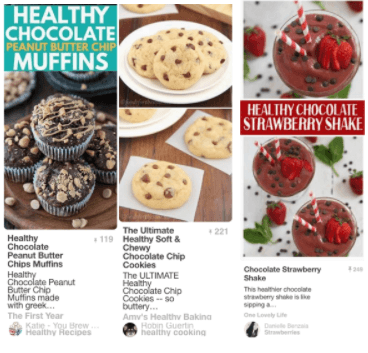The Race for Real-Time on Social Media

It may seem that Twitter has cornered the market on real-time updates, but other networks have launched features that indicate they too want users to share and interact with the most up-to-the-moment information.
The benefits of real-time marketing for brands includes higher return on investment by some accounts, better engagement by capitalizing on current events and greater brand reach. Let's explore the real-time features each social network offers in order to know how they prioritize in the moment so brands can adapt accordingly.
The fact that Pins circulate and get re-pinned over (and over), would make the average user think that the network doesn't surface suggestions in real-time. Pinterest engineers, however, created Pixie, a system for making personalized recommendations in real-time.
According to Pinterest, Pixie now powers recommendations across the network in Related Pins, home feed and Explore, and accounts for about half of all Pins saved. So, for instance, if a user interacts with these three Pins:

Pixie could surface thousands of similar Pins in real-time.
Pinterest reports that the system improves user engagement by up to 50 percent and also improves the ecosystem by recommending previously undiscovered content. To take advantage of this system, marketers need to optimize their profiles and Pins for discovery with appropriate keyword usage, high-quality images and other optimization strategies found in this article, "Pinterest Visibility Strategies for Pins & Profiles."
The newest real-time news to make its way out of Facebook via Instagram via Snapchat is Facebook Stories, which currently - as many users can attest to - has very little engagement. Stories promote the use of in-the-moment videos and images that "disappear" after 24 hours.
To gain steam, Facebook may have to shell out millions of dollars to creators like it did last year with Facebook Live. According to the Wall Street Journal, Facebook agreed to make payments to video creators totaling more than $50 million to jumpstart its live-streaming video feature.
Since influencers are already creating ephemeral messaging elsewhere (Snapchat, originally, and then Instagram), it would make sense to partner with influencers to encourage everyday users to start posting Stories on Facebook the same way Facebook did for Live. Today, however, Stories are only available to non-commercial users (e.g., profiles not Pages). Brands will want to keep a close eye on Stories for their own use and consider another real-time offering Facebook offers - the previously mentioned Facebook Live.
It's been reported that Facebook ranks Live video over uploaded video in its News Feed algorithms. Any and every advantage that a brand can take to secure more organic reach should be seized and Facebook Live is a good place to start. For some Live video examples, read, "Facebook Live Up Close & Personal."
Snapchat
The network that made disappearing posts popular, is rolling out Stories in Search in select cities, which could rival the real-time benefits of Twitter (breaking news, event commentary) but for a millennial, app-only audience. Stories in Search takes the app's previous idea, Our Story, and makes it searchable.
Our Story is a collection of Stories that people have submitted and have been curated by Snapchat. Our Stories allows people to see behind-the-scenes Snaps from live events like the Super Bowl or what's going on in Downtown Hollywood on a Friday night (or even at a specific restaurant or venue). Using machine learning, Snapchat is now able to understand what's happening in Snaps that are submitted to Our Story - likely similar to how Facebook analyzes images and videos to deliver a Facebook Memory that a person is most likely to share - so they can be categorized appropriately to deliver relevant results to a person's query.
Say a 20-something wants to see if their favorite bar is busy on a Saturday night, this is essentially where they could check Our Story to get real-time views to decide if they should go elsewhere or the same person checking out what people are wearing before deciding on an outfit (checking Snapchat versus Pinterest). While we've discouraged brands from adding Snapchat to their list of social networks to manage if their target audience is not using the app, Stories in Search provides a compelling case for local businesses to get ahead of what is likely to become a very popular feature.
A local business should consider adding a geo-filter on Snapchat so that when people do show off what they are doing at that establishment, they can add the filter (because Snapchat people just do that) and the business benefits from the patron using the branding they've suggested. Businesses can upload their own design or use Snapchat's drag-and-drop creator to submit a geofilter.
Snapchat is creating its own (albeit somewhat confusing) world full of user-uploaded content and companies need to get ahead of how its very active, engaged audience is using the features.
When breaking news happens, it's Twitter that people often turn to in order to get real-time information that perhaps credited news organizations don't have yet or aren't able to confirm yet. Twitter lives in this real-time world, and it's the other networks vying to replace it as the primary place people get breaking news, event commentary, etc. Google, however, decided not to try and beat Twitter at its own game but rather join it by surfacing real-time Tweets in its search results.
W hen a brand engages in real-time marketing - whether it's a Twitter chat, replies about breaking news, Tweets about a sports or entertainment event - they are more likely to have their Tweets and profile appear in Google search results, which could increase their follower numbers and their engagement levels.
Twitter is currently the most effective platform to join conversations about pop culture, events, news and more. Check out these "10 Timely Tweets" for inspiration.
Get Real
Each of these networks are prioritizing real-time content, which will require brands to re-think how they involve themselves (or don't) in breaking news, user-generated content and more.
One thing is for sure, companies will need to listen to the social airwaves both for brand mentions and for industry happenings so they can comment when necessary. For those businesses worried about making mistakes by engaging in real-time marketing, know that mediums like Facebook Live and Snapchat Stories are meant to be raw, in-the-moment photos and videos so while they should of course refrain from offensive language and comments, innocent blunders will add to the appeal of the posts because they are authentic and not staged.
For the companies that decide not to participate in real-time marketing at all, having optimized profiles and posts that are relevant and updated regularly, will allow the networks to surface these as they see fit. In other words, marketers should know that engineers are working to match content and people, so keep posting whether it's scheduled or not.

Subscribe to Our Newsletter!
Latest in Social Media










